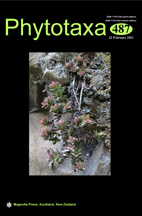Abstract
Govenia utriculata (Sw.) Lindl. has been pervasively confused in herbaria and the literature, despite showing both vegetative and florally distinctive attributes. Here we document for the first time its presence in Mexico, provide a description, a detailed drawing and color photographs from live flowering plants, and compare it with its congeners. All verifiable records indicate that G. utriculata is restricted to the Bahamas, the Greater Antilles, and now also Mexico; literature reports from elsewhere were based on misidentifications. Govenia utriculata is distinguished by the large inflated sheath enclosing the leaf petioles, which in living condition is circular in cross section and partially filled with rainwater; such ample sheath is evident in herbarium specimens and shared only by Mexican endemic G. lagenophora Lindl. Florally, G. utriculata is recognized by its small, white flowers, narrowly elliptic, falcate, acute petals with transverse magenta bars above the middle of their inner surface, and narrowly ovate, acuminate labellum with longitudinal keels only below the middle. The single known Mexican population of G. utriculata occurs in a tropical deciduous forest nature reserve (Sierra Montenegro) in the state of Morelos, and thus is under nominal protection; moderate disturbance from trampling and nearby agriculture and cattle ranching was observed in the location but the population seems to be tolerant to such disturbance and all reproductive individuals were found in partially open areas and forest edges. All Mexican plants examined had auto-pollinating flowers; auto-pollination resulted from germination of the pollen on the rostellum briefly before anthesis, apparently precluding cross-pollination as the pollinia are stuck to the rostellum when the flowers open.

